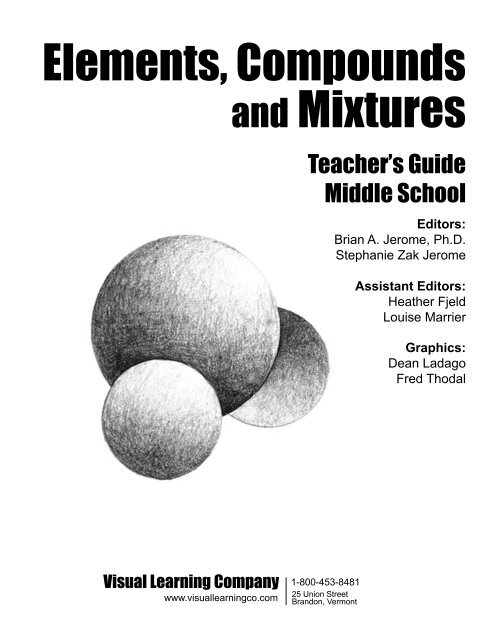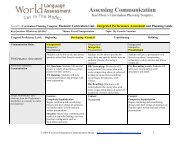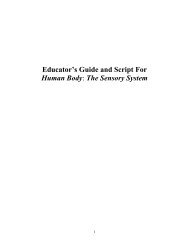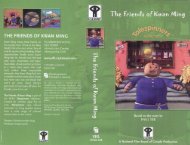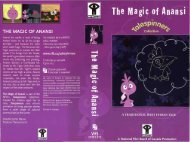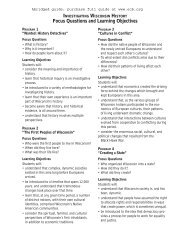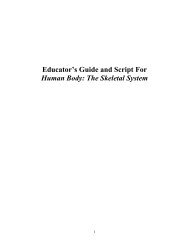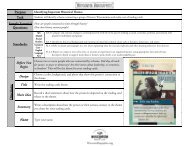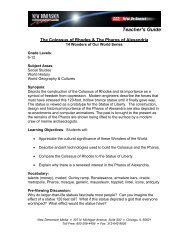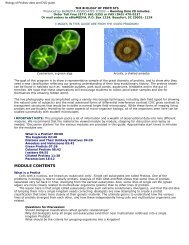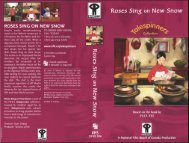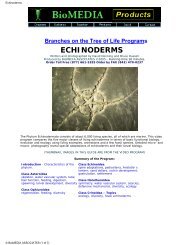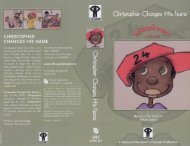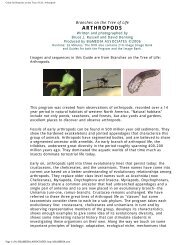Elements, Compounds, Mixtures
Elements, Compounds, Mixtures
Elements, Compounds, Mixtures
Create successful ePaper yourself
Turn your PDF publications into a flip-book with our unique Google optimized e-Paper software.
<strong>Elements</strong>, <strong>Compounds</strong><br />
and <strong>Mixtures</strong><br />
Visual Learning Company 1-800-453-8481<br />
25 Union Street<br />
Teacher’s Guide<br />
Middle School<br />
Brian A. Jerome, Ph.D.<br />
Stephanie Zak Jerome<br />
Assistant Editors:<br />
Heather Fjeld<br />
Louise Marrier<br />
Graphics:<br />
Dean Ladago<br />
Fred Thodal<br />
www.visuallearningco.com Brandon, Vermont<br />
Editors:
<strong>Elements</strong>, <strong>Compounds</strong>, and <strong>Mixtures</strong><br />
Use and Copyright:<br />
The purchase of this video program entitles the user to reproduce or duplicate,<br />
in whole or in part, this teacher’s guide and the blackline master handouts for<br />
the purpose of teaching in conjunction with this video, <strong>Elements</strong>, <strong>Compounds</strong>,<br />
and <strong>Mixtures</strong>. The right is restricted for use only with this video program. Any<br />
reproduction or duplication, in whole or in part, of this guide and student masters for<br />
any purpose other than for use with this video program is prohibited.<br />
The video and this teacher’s guide are the exclusive property<br />
of the copyright holder. Copying, transmitting or reproducing<br />
in any form, or by any means, without prior written permission<br />
from the copyright holder is prohibited (Title 17, U.S. Code<br />
Sections 501 and 506).<br />
Copyright © 2005<br />
ISBN 1-59234-097-0<br />
Visual Learning Company 1-800-453-8481 www.visuallearningco.com<br />
2
<strong>Elements</strong>, <strong>Compounds</strong>, and <strong>Mixtures</strong><br />
Table of Contents<br />
A Message From Our Company<br />
National Standards Correlations<br />
Student Learning Objectives<br />
Assessment<br />
Introducing the Video<br />
Video Viewing Suggestions<br />
Video Script<br />
Student Assessments and Activities<br />
Answers to Student Assessments<br />
Answers to Student Activities<br />
Assessment and Student Activity Masters<br />
Page<br />
5<br />
6<br />
7<br />
8<br />
9<br />
9<br />
10<br />
16<br />
17<br />
18<br />
19<br />
3<br />
www.visuallearningco.com<br />
1-800-453-8481<br />
Visual Learning Company
<strong>Elements</strong>, <strong>Compounds</strong>, and <strong>Mixtures</strong><br />
Viewing<br />
Clearances<br />
The video and accompanying teacher’s guide are for instructional use only. In<br />
showing these programs, no admission charges are to be incurred. The programs<br />
are to be utilized in face-to-face classroom instructional settings, library settings, or<br />
similar instructional settings.<br />
Duplication rights are available, but must be negotiated with the<br />
Visual Learning Company.<br />
Television, cable or satellite rights are also available, but must be<br />
negotiated with the Visual Learning Company.<br />
Closed circuit rights are available, and are defined as the use of the program<br />
beyond a single classroom but within a single campus. Institutions wishing to utilize<br />
the program in multiple campuses must purchase the multiple campus version of the<br />
program, available at a slightly higher fee.<br />
Discounts may be granted to institutions interested in purchasing programs in large<br />
quantities. These discounts may be negotiated with the Visual Learning Company.<br />
Visual Learning Company 1-800-453-8481 www.visuallearningco.com<br />
4
<strong>Elements</strong>, <strong>Compounds</strong>, and <strong>Mixtures</strong><br />
A Message from<br />
our Company . . .<br />
Dear Educator:<br />
Thank you for your interest in the educational videos produced by the Visual<br />
Learning Company. We are a Vermont-based, family owned and operated business<br />
specializing in the production of quality educational science videos and materials.<br />
We have a long family tradition of education. Our grandmothers graduated from<br />
normal school in the 1920’s to become teachers. Brian’s mother was an elementary<br />
teacher and guidance counselor, and his father was a high school teacher and<br />
superintendent. This family tradition inspired Brian to become a science teacher,<br />
and to earn a Ph.D. in education, and led Stephanie to work on science educational<br />
programs at NASA.<br />
In developing this video, accompanying teacher’s guide, and student activities,<br />
our goal is to provide educators with the highest quality materials, thus enabling<br />
students to be successful. In this era of more demanding standards and<br />
assessment requirements, supplementary materials need to be curricular and<br />
standards based - this is what we do!<br />
Our videos and accompanying materials focus on the key concepts and<br />
vocabulary required by national and state standards and goals. It is our mission to<br />
help students meet these goals and standards, while experiencing the joy and<br />
thrill of science.<br />
Sincerely,<br />
Brian and Stephanie Jerome<br />
5<br />
www.visuallearningco.com<br />
1-800-453-8481<br />
Visual Learning Company
<strong>Elements</strong>, <strong>Compounds</strong>, and <strong>Mixtures</strong><br />
National Standards Correlations<br />
National Science Education Standards<br />
(Content standards: 5-8, National Academy of Sciences, c. 1996)<br />
Physical Science - Content Standard B:<br />
As a result of their activities in grades 5-8, all students should develop an<br />
understanding that:<br />
• A substance has characteristic properties, such as density, a boiling point,<br />
and solubility, all of which are independent of the amount of the sample. A<br />
mixture of substances can often be separated into the original substances<br />
using one or more of the characteristic properties.<br />
• Substances react chemically in characteristic ways with other substances<br />
to form new substances (compounds) with different characteristic<br />
properties. In chemical reactions, the total mass is conserved. Substances<br />
often are placed in categories or groups if they react in similar ways; metals<br />
are an example of such a group.<br />
• Chemical elements do not break down during normal laboratory reactions<br />
involving such treatments as heating, exposure to electric current, or<br />
reaction with acids. There are more than 100 known elements that<br />
combine in a multitude of ways to produce compounds, which account for<br />
the living and nonliving substances we encounter.<br />
Benchmarks for Science Literacy<br />
(Project 2061 – AAAS, c. 1993)<br />
The Physical Setting - Structure of Matter (4D)<br />
By the end of 8 th grade, students should know that:<br />
• All matter is made up of atoms, which are far too small to be seen directly<br />
through a microscope. The atoms of any element are alike but are different<br />
from atoms of other elements. Atoms may stick together in well-defined<br />
molecules or may be packed together in large arrays. Different<br />
arrangements of atoms into groups compose all substances.<br />
• Atoms and molecules are perpetually in motion. Increased temperature<br />
means greater average energy of motion, so most substances expand<br />
when heated. In solids, the atoms are closely locked in position and can<br />
only vibrate. In liquids, the atoms or molecules have higher energy<br />
of motion, are more loosely connected, and can slide past one another;<br />
some molecules have still more energy of motion and are free of one<br />
another except during collisions.<br />
Visual Learning Company 1-800-453-8481 www.visuallearningco.com<br />
6
<strong>Elements</strong>, <strong>Compounds</strong>, and <strong>Mixtures</strong><br />
Student Learning<br />
Objectives<br />
Upon viewing the video and completing the enclosed student activities,<br />
students will be able to do the following:<br />
• Describe an atom as the smallest possible piece of a pure substance that still has<br />
the properties of that substance.<br />
• Cite the definition of the term “element” and provide several examples of elements.<br />
• Explain the importance of compounds, and generally describe how compounds<br />
are formed when two or more elements chemically combine.<br />
• Create a diagram of a water molecule, consisting of two hydrogen atoms and one<br />
oxygen atom.<br />
• Describe the characteristics of mixtures, and provide an example of a common<br />
mixture.<br />
• Differentiate between a homogeneous mixture and a heterogenous mixture. Cite<br />
an example of each of these mixtures.<br />
• Explain the characteristics of a colloid, and provide an example of a colloid.<br />
• Describe the characteristics of a suspension, and provide an example of a<br />
suspension.<br />
• Define a solution as a type of homogeneous mixture in which the components are<br />
evenly mixed.<br />
• Differentiate between the solute and the solvent in a solution.<br />
• Describe some of the factors which affect the rate of solubility of a solute in a<br />
solvent.<br />
7<br />
www.visuallearningco.com<br />
1-800-453-8481<br />
Visual Learning Company
<strong>Elements</strong>, <strong>Compounds</strong>, and <strong>Mixtures</strong><br />
Assessment<br />
Preliminary Assessment:<br />
The Preliminary Assessment, provided in the Student Masters section, is an<br />
assessment tool designed to gain an understanding of students’ pre-existing<br />
knowledge. It can also be used as a benchmark upon which to assess student<br />
progress based on the objectives stated on the previous pages.<br />
Video Review:<br />
The Video Review, provided in the Student Masters section, can be used as an<br />
assessment tool or as a student activity. There are two main parts. The first part<br />
contains questions that can be answered during the video. The second series of ten<br />
questions consists of a video quiz to be answered at the conclusion of the video.<br />
Post Assessment:<br />
The Post Assessment, provided in the Student Masters section, can be utilized as<br />
an assessment tool following student completion of the video and student activities.<br />
The results of the Post Assessment can be compared against the results of the<br />
Preliminary Assessment to evaluate student progress.<br />
Visual Learning Company 1-800-453-8481 www.visuallearningco.com<br />
8
<strong>Elements</strong>, <strong>Compounds</strong>, and <strong>Mixtures</strong><br />
Introducing the Video<br />
Before viewing the program, gather together examples of elements,<br />
compounds, and mixtures. Examples of elements which are easy to find include<br />
a piece of copper wire, or aluminum flashing. Examples of compounds might<br />
include water, salt, baking soda, or vinegar. Examples of mixtures might include<br />
milk, granite, salad dressing, or toothpaste. Place one or more examples of an<br />
element, compound, and mixture on a table in front of the class. Ask the class to<br />
describe and identify each substance.<br />
Next, tell the students that these substances are quite different from each<br />
other. Ask them how they think the substances are different from each other.<br />
Write their answers on the board. Explain to students that these materials can be<br />
categorized based on whether they are elements, compounds, or mixtures. Write<br />
the definition of each of these terms on the board. Now ask students to figure<br />
out which of the substances are elements, compounds, and mixtures. Ask them<br />
to explain their rationale for categorizing the substances. Explain to students<br />
that they use many different examples of elements, compounds, and mixtures<br />
everyday. Tell students to pay close attention to the program to learn more about<br />
the fascinating characteristics of elements, compounds, and mixtures.<br />
Video Viewing Suggestions<br />
The student master “Video Review” is provided for distribution to students. You<br />
may choose to have your students complete this master while viewing the program<br />
or to do so upon its conclusion.<br />
The program is approximately 20 minutes in length and includes a ten question<br />
video quiz. Answers are not provided to the Video Quiz on the video, but are<br />
included in this teacher’s guide. You may choose to grade student quizzes as an<br />
assessment tool or to review the answers in class.<br />
The video is content-rich with numerous vocabulary words. For this reason you<br />
may want to periodically stop the video to review and discuss new<br />
terminology and concepts.<br />
9<br />
www.visuallearningco.com<br />
1-800-453-8481<br />
Visual Learning Company
<strong>Elements</strong>, <strong>Compounds</strong>, and <strong>Mixtures</strong><br />
Video Script: <strong>Elements</strong>,<br />
<strong>Compounds</strong>, and <strong>Mixtures</strong><br />
1. Look around you for a few seconds. What do you see?<br />
2. Perhaps you see the inside of a building including windows and doors.<br />
3. Maybe you see desks and chairs.<br />
4. Or, maybe you see books, papers, pencils, and pens.<br />
5. Perhaps you even see other people.<br />
6. Have you ever wondered what all these things are made of?<br />
7. Or, have you ever wondered what makes something like this piece of wood. . .<br />
8. . . . different from this piece of copper wire?<br />
9. What is the difference between ocean water. . .<br />
10. . . . and lake water?<br />
11. During the next few minutes we are going to explore many of these questions and<br />
others. . .<br />
12. . . . as we examine some of the fascinating characteristics of elements, compounds,<br />
and mixtures.<br />
13. Graphic Transition – Small Particles<br />
14. This is a piece of copper flashing.<br />
15. It is sometimes used on roofs to help protect wood underneath it.<br />
16. Let us cut it in half, then cut it in half again, and then cut it in half again.<br />
17. You Decide! If it were possible to continue to cut the copper in half, what is the<br />
smallest possible piece that we could make?<br />
18. The smallest possible piece is an atom. What is an atom?<br />
19. An atom is the smallest possible piece of a pure substance that still has the properties<br />
of that substance.<br />
20. Atoms are the building blocks of matter.<br />
21. All matter, including the human body is made up of atoms.<br />
22. Over hundreds of years, scientists have worked hard to try to understand the<br />
characteristics of matter. This is a simplified diagram of an atom magnified millions<br />
of times.<br />
23. One of the many things scientists discovered is that there are many different kinds<br />
of atoms. They also learned that the characteristics of matter are determined by the<br />
kinds of atoms that are in a specific type of matter.<br />
24. A substance or a piece of matter that is made up of just one kind of atom is called an<br />
element.<br />
Visual Learning Company 1-800-453-8481 www.visuallearningco.com<br />
10
<strong>Elements</strong>, <strong>Compounds</strong>, and <strong>Mixtures</strong><br />
Script: (cont.)<br />
25. Let us take a closer look at elements.<br />
26. Graphic Transition - <strong>Elements</strong><br />
27. What does this piece of gold. . .<br />
28. . . . this helium gas filling this balloon. . .<br />
29. . . . and this piece of aluminum have in common?<br />
30. That is right, they are all elements.<br />
31. An element is often thought of as a pure substance because it is made up of just one<br />
kind of atom. This piece of aluminum is an element and is made up of aluminum<br />
atoms.<br />
32. If we could zoom in on the aluminum atoms in this piece of aluminum, they would<br />
all look something like this.<br />
33. And, if we could zoom in on the helium atoms inside this balloon, they would all<br />
look something like this.<br />
34. There are over 100 known elements on Earth. Some of these elements occur<br />
naturally.<br />
35. And some of these elements are made up by people in laboratories.<br />
36. Keep in mind that different elements are made of different atoms which have<br />
different structures.<br />
37. And, elements cannot be changed into a simpler substance.<br />
38. For example, if you were to smash this piece of iron into smaller pieces, or. . .<br />
39. . . . heat it, it is still the element iron.<br />
40. Graphic Transition – <strong>Compounds</strong><br />
41. While there are many different elements, a pure form of an element, like sulfur, is<br />
rare in nature.<br />
42. Instead, elements are more commonly found linked to other elements.<br />
43. Two or more elements chemically combined form a compound.<br />
44. A compound is matter made of atoms of two or more elements that are chemically<br />
bound together.<br />
45. There are millions of compounds on Earth.<br />
46. Many of these compounds are found in living things.<br />
47. And, many are found in non-living things such as these rocks.<br />
48. Most of the foods we eat are made up of chemical compounds.<br />
49. And most of the clothes we wear are made of compounds.<br />
50. Water is a very common compound found most places on Earth.<br />
51. Our bodies need water to survive. . .<br />
52. . . . and we use it for all kinds of things.<br />
53. You Decide! What atoms make up water?<br />
11<br />
www.visuallearningco.com<br />
1-800-453-8481<br />
Visual Learning Company
<strong>Elements</strong>, <strong>Compounds</strong>, and <strong>Mixtures</strong><br />
Script (cont.)<br />
54. Water is made up of two hydrogen atoms and one oxygen atom.<br />
55. These atoms combine to form the compound known as water.<br />
56. The smallest piece of water is called a molecule.<br />
57. A molecule is the smallest particle of a compound that still has all the properties of<br />
the compound.<br />
58. Molecules are made up of two or more chemically bonded atoms.<br />
59. A water molecule is made up of two hydrogen atoms and one oxygen atom.<br />
60. Graphic Transition – <strong>Mixtures</strong><br />
61. Look closely at the salad dressing in this bottle. Notice how there are many different<br />
types of things in it.<br />
62. Look at the particles of sand on this beach. Notice how there are many different<br />
types of particles that make up the sand.<br />
63. You Compute! How many different ingredients can you identify in this breakfast<br />
cereal?<br />
64. There are four different ingredients including oats, sunflower seeds, raisins, and<br />
pumpkin seeds.<br />
65. All of these are examples of mixtures. A mixture is matter that consists of two or<br />
more substances mixed together but not chemically combined. Unlike a compound,<br />
the components in a mixture do not combine chemically and therefore can be<br />
separated.<br />
66. In a mixture, each of the different substances maintains its own properties.<br />
67. In vegetable soup, for example, there are many different vegetables including<br />
carrots, peas, and celery. Each maintains its individual taste. And when combined<br />
with the soup broth they form a mixture we know as vegetable soup.<br />
68. Graphic Transition – Types of <strong>Mixtures</strong><br />
69. The rock in this cliff is a type of rock called granite.<br />
70. A close inspection of granite often reveals several different types of minerals.<br />
71. Granite is a mixture made of several different minerals.<br />
72. You Observe! Do the minerals form a regular or irregular pattern?<br />
73. You can see that the minerals form an irregular pattern.<br />
74. A mixture that is not the same throughout is called a heterogeneous mixture.<br />
75. A heterogeneous mixture such as concrete is not very well mixed compared to other<br />
types of mixtures. . .<br />
76. . . . and you can see small pebbles and other particles scattered randomly throughout.<br />
77. Oil and vinegar salad dressing is another example of a heterogeneous mixture. If<br />
left on the shelf, the oil and vinegar actually separate.<br />
78. Does this toothpaste or. . .<br />
Visual Learning Company 1-800-453-8481 www.visuallearningco.com<br />
12
<strong>Elements</strong>, <strong>Compounds</strong>, and <strong>Mixtures</strong><br />
Script (cont.)<br />
79. . . . this grape juice look the same throughout? Yes, they do.<br />
80. These substances are mixtures that appear the same throughout and are called<br />
homogeneous mixtures.<br />
81. Substances such as whipped cream are special types of homogeneous mixtures<br />
called colloids.<br />
82. Colloids, such as this gelatin, are mixtures in which particles are mixed together, but<br />
not dissolved.<br />
83. Instead, the particles are suspended and do not settle out.<br />
84. Colloids often appear cloudy and the particles in a colloid tend to scatter light that<br />
enters the mixture.<br />
85. The particles are very small, but are large enough to reflect light.<br />
86. In some mixtures, called suspensions, the particles found in the liquid are large and<br />
can settle out. Suspensions are heterogeneous mixtures with larger particles.<br />
87. The water taken from this rushing river contains many particles of dirt and soil.<br />
88. If a sample of the river water is allowed to sit still for several days, these particles<br />
settle to the bottom.<br />
89. Many medicines are suspensions. There are directions written on the container to<br />
“Shake Well.”<br />
90. This is because particles often settle to the bottom over time, and need to become<br />
resuspended or redispersed before the medicine can be used.<br />
91. Graphic Transition - Solutions<br />
92. You Compare! What is the difference between ocean water and lake water?<br />
93. Water in the ocean is saltwater, whereas. . .<br />
94. . . . water in lakes is referred to as freshwater.<br />
95. Both are examples of solutions.<br />
96. A solution is a type of homogeneous mixture in which the components are evenly<br />
mixed.<br />
97. In a solution one substance is always dissolved.<br />
98. In the process of dissolving, particles of substances separate and spread evenly<br />
throughout a mixture.<br />
99. With the case of powdered fruit drink. . .<br />
100. . . . the water is the substance into which the powder is dissolved. The water is<br />
called the solvent.<br />
101. And the powdered drink is called the solute.<br />
102. It is very difficult to see the particles in the drink, making it hard to physically<br />
separate the solution.<br />
103. Water can dissolve many things and is often referred to as the universal solvent.<br />
13<br />
www.visuallearningco.com<br />
1-800-453-8481<br />
Visual Learning Company
<strong>Elements</strong>, <strong>Compounds</strong>, and <strong>Mixtures</strong><br />
Script (cont.)<br />
104. In the case of saltwater, different kinds of salts are dissolved in water giving ocean<br />
water a uniform salty taste.<br />
105. And freshwater is a solution containing many dissolved minerals such as iron.<br />
106. Solutions do not necessarily have to be liquids.<br />
107. There are many different kinds of solutions, and hundreds of different examples of<br />
each.<br />
108. Graphic Transition – Solutions in Action<br />
109. As we just discussed, many things can be dissolved in water.<br />
110. Sugar, for example, is soluble in water.<br />
111. Oil, on the other hand, is insoluble, and cannot be dissolved in water.<br />
112. The amount of solute that can be dissolved in a solvent is referred to as solubility.<br />
113. If we were to continue adding sugar to this container of water, it would eventually<br />
settle out at the bottom.<br />
114. This is because the water can only dissolve so much solute. In other words, the<br />
water cannot hold any more sugar. At this point, the solution is said to be saturated.<br />
115. A saturated solution holds all the solute it will dissolve at a certain temperature and<br />
pressure.<br />
116. But, by increasing the temperature, for example, the solvent can often dissolve<br />
more solute.<br />
117. Other factors affect the rate of solubility, including particle size and movement.<br />
118. This is just a quick look at some of the complex nature of solutions.<br />
119. Graphic Transition – Summing Up<br />
120. During the past few minutes we have explored some of the fascinating features of<br />
elements, compounds, and mixtures.<br />
121. We saw how matter is made up of tiny particles called atoms . . .<br />
122. . . . and how matter is made up of different kinds of atoms.<br />
123. We described an element as matter made up of just one kind of atom.<br />
124. And, that an element cannot be changed into a simpler substance.<br />
125. We explored how compounds are formed from two or more elements combining.<br />
126. Water is an example of a molecule made up of two atoms of hydrogen and one<br />
atom of oxygen.<br />
127. We saw how a mixture, such as this breakfast cereal, consists of matter that consists<br />
of two or more substances mixed together but not chemically combined.<br />
128. We explored some different types of mixtures and their characteristics. . .<br />
129. . . . including heterogeneous mixtures such as concrete. . .<br />
130. . . . and homogeneous mixtures such as toothpaste.<br />
Visual Learning Company 1-800-453-8481 www.visuallearningco.com<br />
14
<strong>Elements</strong>, <strong>Compounds</strong>, and <strong>Mixtures</strong><br />
Script (cont.)<br />
131. We briefly discussed the characteristics of colloids. . .<br />
132. . . . as well as another type of mixture called suspensions.<br />
133. Finally, we briefly discussed some of the characteristics of solutions.<br />
134. So, the next time you touch a piece of matter.<br />
135. Brush your teeth with toothpaste.<br />
136. Or mix up some powdered fruit drink; think about some of the things we have<br />
discussed the past few minutes.<br />
137. You just might think about elements, compounds, and mixtures a little differently.<br />
Fill in the correct word to complete the sentence. Good luck and let us get started.<br />
1. ________ are the building blocks of matter.<br />
2. An ________ is made up of just one kind of atom.<br />
3. Water is an example of a ________.<br />
4. A __________ is the smallest piece of a compound.<br />
5. Vegetable soup is an example of a _________.<br />
6. Concrete is an example of a _________ mixture.<br />
7. A homogeneous mixture is _____ mixed.<br />
8. Whipped cream is an example of a _________.<br />
9. In a __________ one substance is dissolved.<br />
10. Water is often called the universal ___________.<br />
15<br />
www.visuallearningco.com<br />
1-800-453-8481<br />
Visual Learning Company
<strong>Elements</strong>, <strong>Compounds</strong>, and <strong>Mixtures</strong><br />
Student Assessments<br />
And Activities<br />
Assessment Masters:<br />
• Preliminary Assessment<br />
• Video Review<br />
• Post Assessment<br />
Student Activity Masters:<br />
• Comparing <strong>Compounds</strong><br />
• Mixing <strong>Mixtures</strong><br />
• Vocabulary of <strong>Elements</strong>, <strong>Compounds</strong>, and <strong>Mixtures</strong><br />
Visual Learning Company 1-800-453-8481 www.visuallearningco.com<br />
16
Answers to Student<br />
Assessments<br />
<strong>Elements</strong>, <strong>Compounds</strong>, and <strong>Mixtures</strong><br />
Preliminary Assessment (pgs. 20-21)<br />
1. particles<br />
2. atoms<br />
3. element<br />
4. compound<br />
5. molecule<br />
6. mixture<br />
7. heterogeneous<br />
8. homogeneous<br />
9. solution<br />
10. suspension<br />
11. true<br />
12. false<br />
13. false<br />
14. true<br />
15. true<br />
16. true<br />
17. false<br />
18. false<br />
19. false<br />
20. true<br />
Video Review (pg. 22)<br />
1. The smallest possible piece is an<br />
atom.<br />
2. Two hydrogen atoms and one<br />
oxygen atom make up water.<br />
3. There are four different ingredients<br />
including oats, sunflower seeds,<br />
raisins, and pumpkin seeds.<br />
4. The minerals form an irregular<br />
pattern.<br />
5. The water in oceans is salt water<br />
and water in lakes is fresh water.<br />
Both types of water are solutions.<br />
Video Quiz (pg. 22)<br />
1. atoms<br />
2. element<br />
3. compound<br />
4. molecule<br />
5. mixture<br />
6. heterogeneous<br />
7. well<br />
8. colloid<br />
9. solution<br />
10. solvent<br />
Post Assessment (pgs. 23-24)<br />
1. false<br />
2. true<br />
3. true<br />
4. true<br />
5. true<br />
6. false<br />
7. false<br />
8. true<br />
9. false<br />
10. false<br />
11. element<br />
12. particles<br />
13. suspension<br />
14. molecule<br />
15. compound<br />
16. atoms<br />
17. homogeneous<br />
18. mixture<br />
19. solution<br />
20. heterogeneous<br />
17<br />
www.visuallearningco.com<br />
1-800-453-8481<br />
Visual Learning Company
<strong>Elements</strong>, <strong>Compounds</strong>, and <strong>Mixtures</strong><br />
Answers to Student Activities<br />
Comparing <strong>Compounds</strong> (pgs. 25-27)<br />
1. Iron has magnetic properties<br />
and sulfur doesn’t have magnetic<br />
properties. Both are in solid form.<br />
2. When in a mixture, the iron is<br />
drawn toward the magnet and the<br />
sulfur is not. The sulfur doesn’t<br />
move toward the magnet unless the<br />
iron drags the sulfur with it.<br />
3. The iron responded to the magnet.<br />
4. It is possible to separate the iron<br />
and sulfur mixture into its individual<br />
parts. The iron could be drawn<br />
toward the magnet and lifted away<br />
from the sulfur.<br />
5. The sulfur and iron mixture<br />
changed into a dark grey solid after<br />
it was heated. The compound was<br />
drawn to the magnet.<br />
Mixing <strong>Mixtures</strong> (pgs. 28-29)<br />
1. A homogeneous mixture is a<br />
mixture that is the same<br />
throughout. A heterogeneous<br />
mixture is a mixture that is not the<br />
same throughout. Heterogeneous<br />
mixtures are not as well mixed as<br />
homogeneous mixtures are.<br />
2. The bean-rice-pea mixture was<br />
a heterogeneous mixture because<br />
it was not the same throughout. It<br />
was possible to see the three<br />
different ingredients by looking at<br />
the mixture.<br />
3. Five possible examples of<br />
heterogeneous mixtures include:<br />
breakfast cereal, concrete, vegetable<br />
soup, oil and vinegar salad dressing,<br />
and rocks such as granite.<br />
4. Both milk and the powdered fruit drink<br />
are homogeneous mixtures because<br />
they are the same throughout.<br />
5. Five examples of homogeneous<br />
mixtures include: freshwater,<br />
saltwater, toothpaste, grape juice,<br />
and whipped cream.<br />
Vocabulary (pg. 30)<br />
1. j - solvent<br />
2. d - suspension<br />
3. i - mixture<br />
4. h - compound<br />
5. b - molecule<br />
6. g - element<br />
7. a - atom<br />
8. c - colloid<br />
9. e - solute<br />
10. f - solution<br />
Visual Learning Company 1-800-453-8481 www.visuallearningco.com<br />
18
Assessment<br />
and Student<br />
Activity<br />
Masters
<strong>Elements</strong>, <strong>Compounds</strong>, and <strong>Mixtures</strong><br />
Name<br />
Preliminary Assessment<br />
Directions: Fill in the blank with the correct word. A list of possible answers<br />
is provided at the bottom of the page.<br />
1. Matter is made up of tiny _______________.<br />
2. _______________ are the building blocks of matter.<br />
3. An _______________ is made up of just one kind of atom.<br />
4. Two or more elements chemically combined form a _______________.<br />
5. A _______________ of water is made up of two hydrogen atoms and one<br />
oxygen atom.<br />
6. Vegetable soup is an example of a _______________.<br />
7. A mixture that is not the same throughout is called a _______________<br />
mixture.<br />
8. Seawater is an example of a _______________ mixture because it is the<br />
same throughout.<br />
9. In a _______________ one substance is dissolved in another.<br />
10. In a mixture called a _______________ the particles are larger and can<br />
settle out.<br />
atoms<br />
compound<br />
element<br />
heterogeneous<br />
homogeneous<br />
mixture<br />
molecule<br />
particles<br />
solution<br />
suspension<br />
®2005<br />
20
<strong>Elements</strong>, <strong>Compounds</strong>, and <strong>Mixtures</strong><br />
Name<br />
Preliminary Assessment<br />
Directions: Decide whether the answer is True (T) or False (F).<br />
11. The smallest part of an element is an atom.<br />
T<br />
F<br />
12. Matter made up of just one kind of element is a compound.<br />
T<br />
F<br />
13. There are less that 50 known elements on Earth.<br />
T<br />
F<br />
14. Water is a common compound on Earth.<br />
T<br />
F<br />
15. The components in a mixture do not combine chemically.<br />
T<br />
F<br />
16. Oil and vinegar salad dressing is an example of a<br />
heterogeneous mixture.<br />
T<br />
F<br />
17. A homogeneous mixture is not well mixed.<br />
T<br />
F<br />
18. The particles in a suspension always remain suspended.<br />
T<br />
F<br />
19. Water is often called the universal solute.<br />
T<br />
F<br />
20. An increase in temperature and stirring often increase the rate<br />
of solubility.<br />
T<br />
F<br />
®2005<br />
21
<strong>Elements</strong>, <strong>Compounds</strong>, and <strong>Mixtures</strong><br />
Video Review<br />
Name<br />
Directions: During the course of the program, answer the questions as they are<br />
presented in the video. Answer the Video Quiz questions at the end of the video.<br />
You Decide!<br />
1. If it were possible to continue to cut the copper in half, what is the smallest<br />
possible piece we could make?<br />
You Decide!<br />
2. What atoms make up water?<br />
You Compute!<br />
3. How many different ingredients can you identify in this breakfast cereal?<br />
You Observe!<br />
4. Do the minerals form a regular or irregular pattern?<br />
You Compare!<br />
5. What is the difference between ocean water and lake water?<br />
Video Quiz:<br />
1. _______________ are the building blocks of matter.<br />
2. An _______________ is made up of just one kind of atom.<br />
3. Water is an example of a _______________.<br />
4. A _______________ is the smallest piece of a compound.<br />
5. Vegetable soup is an example of a _______________.<br />
6. Concrete is an example of a _______________ mixture.<br />
7. A homogeneous mixture is _______________ mixed.<br />
8. Whipped cream is an example of a _______________.<br />
9. In a _______________ one substance is dissolved.<br />
10. Water is often called the universal _______________.<br />
®2005<br />
22
<strong>Elements</strong>, <strong>Compounds</strong>, and <strong>Mixtures</strong> Name<br />
Post Assessment<br />
Directions: Decide whether the answer is True (T) or False (F).<br />
1. There are less that 50 known elements on Earth.<br />
T<br />
F<br />
2. The smallest part of an element is an atom.<br />
T<br />
F<br />
3. An increase in temperature and stirring often increase the rate of<br />
solubility.<br />
T<br />
F<br />
4. The components in a mixture do not combine chemically.<br />
T<br />
F<br />
5. Water is a common compound on Earth.<br />
T<br />
F<br />
6. Matter made up of just one kind of element is a compound.<br />
T<br />
F<br />
7. The particles in a suspension always remain suspended.<br />
T<br />
F<br />
8. Oil and vinegar salad dressing is an example of a heterogeneous<br />
mixture.<br />
T<br />
F<br />
9. Water is often called the universal solute.<br />
T<br />
F<br />
10. A homogeneous mixture is not well mixed.<br />
T<br />
F<br />
®2005<br />
23
<strong>Elements</strong>, <strong>Compounds</strong>, and <strong>Mixtures</strong><br />
Name<br />
Post Assessment<br />
Directions: Fill in the blank with the correct word. Choose from the list of<br />
possible answers at the bottom of the page.<br />
11. An _______________ is made up of just one kind of atom.<br />
12. Matter is made up of tiny _______________.<br />
13. In a mixture called a ________________ the particles are larger and can settle<br />
out.<br />
14. A _______________ of water is made up of two hydrogen atoms and one<br />
oxygen atom.<br />
15. Two or more elements chemically combined form a _______________.<br />
16. _______________ are the building blocks of matter.<br />
17. Seawater is an example of a _______________ mixture because it is the same<br />
throughout.<br />
18. Vegetable soup is an example of a _______________.<br />
19. In a _______________ one substance is dissolved in another.<br />
20. A mixture that is not the same throughout is called a _______________<br />
mixture.<br />
atoms<br />
compound<br />
element<br />
heterogeneous<br />
homogeneous<br />
mixture<br />
molecule<br />
particles<br />
solution<br />
suspension<br />
®2005<br />
24
<strong>Elements</strong>, <strong>Compounds</strong>, and <strong>Mixtures</strong><br />
Name<br />
Comparing <strong>Compounds</strong><br />
Even though it doesn’t seem possible our bodies, as well as this piece of<br />
paper, and the chair you are sitting on, are made up of millions of tiny particles.<br />
These particles are too small to be seen with the naked eye. In fact, millions of<br />
these particles would fit into the head of a pin! These tiny particles are called atoms.<br />
Atoms are often referred to as the building blocks of matter. An atom is the smallest<br />
part of an element that still has all the properties of that element. As you recall, an<br />
element is a pure substance which is made up of a single kind of atom. There are<br />
over 100 known elements on Earth.<br />
Every time you drink a glass of milk, sprinkle salt on your food, and eat an<br />
apple you are eating chemical compounds. Almost everything we eat, touch, and<br />
see is made up of chemical compounds. But what exactly is a chemical compound?<br />
A compound is a substance that is made up of two or more elements that are<br />
chemically combined.<br />
In this activity you will investigate some of the characteristics of both elements<br />
and compounds. Remember to use caution when performing the experiment in this<br />
investigation. Record your data neatly, and answer the questions at the conclusion<br />
of the activity.<br />
Materials: safety goggles, iron filings, powdered sulfur, paper towel, magnet, plastic<br />
bag or plastic wrap, heat source (Bunsen burner or candle), test tube, test tube<br />
tongs, container with cold water<br />
Directions:<br />
1. Obtain a small amount of powdered sulfur. Place it on a piece of paper towel and<br />
carry it back to your desk.<br />
2. Take a few minutes to make some observations about the element sulfur. Record<br />
your observations in the data table. What is its color? What does it feel like?<br />
Describe its texture. What does it smell like? Don’t put your nose too close to it<br />
to smell it! Record your observations in the data table.<br />
3. Use a plastic bag or plastic wrap to cover the magnet. Touch the covered<br />
magnet to the sulfur and record your observations.<br />
4. Next obtain a small amount of iron filings and place them on a different paper<br />
towel. Carefully take them to your desk.<br />
5. Take a few minutes to make some observations about the iron. Record your<br />
observations in the data table.<br />
6. Draw the magnet toward the iron filings. Record your observations.<br />
®2005<br />
25
<strong>Elements</strong>, <strong>Compounds</strong>, and <strong>Mixtures</strong><br />
Name<br />
Comparing <strong>Compounds</strong> (cont.)<br />
7. If iron filings have stuck to the magnet, wipe as many of them off as possible.<br />
8. Mix the sulfur and iron. Record your observations. Also test the magnetic<br />
properties of the mixture and record your observations.<br />
9. The next part of the activity will be conducted by your teacher.<br />
a. Your instructor will combine the sulfur and iron filings from several<br />
students in a test tube and mix them. The test tube will be about 1/3 to<br />
1/2 full of the mixture.<br />
b. Next, your instructor will put on protective eye wear.<br />
c. He or she will then pick up the test tube with the test tube tongs.<br />
d. The test tube will then be heated over the flame of a Bunsen burner or<br />
candle for five minutes. CAUTION: Care needs to be taken to point<br />
the open end of the test tube away from people!<br />
e. After five minutes the test tube will immediately be immersed in cold<br />
water.<br />
f. If the test tube does not break, then it should be wrapped with paper<br />
towels and carefully broken with a heavy object.<br />
g. Carefully remove the contents while separating them from the pieces of<br />
glass.<br />
10. With your sample of the sulfur iron compound, make some observations in the<br />
data table. Also test the magnetic properties of the sample with a magnet.<br />
11. Answer the following questions.<br />
Questions:<br />
1. Compare and contrast some of the properties of sulfur and iron.<br />
2. What were the properties of the sulfur and iron mixture and how did they differ<br />
from those of the separate elements?<br />
3. What part of the mixture responded to the magnet?<br />
4. Is it possible to separate the sulfur and iron mixture into its individual parts?<br />
5. Discuss how the properties of the sulfur and iron mixture changed after it was<br />
heated.<br />
®2005<br />
26
<strong>Elements</strong>, <strong>Compounds</strong>, and <strong>Mixtures</strong><br />
Name<br />
Comparing <strong>Compounds</strong> (cont.)<br />
Data Table:<br />
Sulfur Iron Sulfur and Iron<br />
Mixture<br />
Sulfur and Iron<br />
Compound<br />
After Heating<br />
Color<br />
Texture and<br />
Feel<br />
Smell<br />
Magnetic<br />
Properties<br />
®2005<br />
27
<strong>Elements</strong>, <strong>Compounds</strong>, and <strong>Mixtures</strong><br />
Name<br />
Mixing <strong>Mixtures</strong><br />
Background: What do the following things have in common: vegetable soup, seawater,<br />
shaving cream, and sand on the beach? If you said that all these things are mixtures<br />
then you are correct. <strong>Mixtures</strong> are very important. We eat many mixtures such as salads,<br />
cereal, and vegetable soup to name just a few. What exactly is a mixture? A mixture is<br />
matter in which two or more substances are mixed together but not chemically combined. A<br />
vegetable salad is a mixture of lettuce, tomatoes, onions, carrots, mushrooms, and peppers.<br />
The ingredients do not chemically combine, but maintain their own properties.<br />
There are thousands of different examples of mixtures. One way to group mixtures<br />
is based on how well mixed they are. <strong>Mixtures</strong> that do not appear to be the same<br />
throughout are called heterogeneous mixtures. Heterogeneous mixtures are the least<br />
mixed type of mixture. Vegetable soup, sand on the beach, and concrete are examples of<br />
heterogeneous mixtures. In heterogeneous mixtures it is often possible to see the different<br />
components in the mixture.<br />
<strong>Mixtures</strong> that are well mixed are referred to as homogeneous mixtures. These types<br />
of mixtures appear the same throughout and it is difficult to see the individual components.<br />
Salt water found in the ocean contains many different minerals, salt, and water, yet it<br />
appears the same throughout. The air we breathe, which contains many different gases is<br />
also an example of a homogeneous mixture.<br />
In this activity you will investigate the properties of both heterogeneous and<br />
homogeneous mixtures. You will do this by creating examples of these mixtures.<br />
Materials: dried beans, rice, peas, sunflower seeds, cup, piece of granite, grape juice,<br />
water, powdered fruit drink, sugar, magnifying glass<br />
Directions:<br />
1. In a paper cup mix together dried beans, rice, peas, and sunflower seeds.<br />
2. Describe the appearance of the mixture. Decide if it is well mixed or poorly mixed.<br />
Is it a heterogeneous or homogeneous mixture? Record your observations in the data<br />
table.<br />
3. Obtain a piece of granite from your teacher. Describe its appearance. Use a magnifying<br />
glass for a closer examination of the rock. Decide if it is well mixed or not. Is it a<br />
heterogeneous or homogeneous mixture? Record your observations in the data table.<br />
4. Your teacher will provide you with a glass of grape juice. Carefully examine the juice.<br />
Record your observations in the data table as you did for the other mixtures.<br />
5. Pour a glass of cold water, then add a teaspoon of powdered fruit drink. Stir until the<br />
powdered fruit drink has dissolved. Next, add a teaspoon of sugar. Stir until the sugar<br />
has dissolved. Observe the drink. Record your observations in the data table.<br />
®2005<br />
28
<strong>Elements</strong>, <strong>Compounds</strong>, and <strong>Mixtures</strong><br />
Name<br />
Mixing <strong>Mixtures</strong> (cont.)<br />
Data Table:<br />
Mixture description<br />
Well mixed or not<br />
well mixed<br />
Homogeneous or<br />
heterogeneous<br />
Questions:<br />
1. Describe the difference between a heterogeneous mixture and a homogeneous mixture.<br />
2. How do you know the bean-rice-pea mixture was a heterogeneous mixture?<br />
3. List five examples of heterogeneous mixtures.<br />
4. How do you know that both grape juice and the powdered fruit drink are homogeneous<br />
mixtures?<br />
5. List five examples of homogeneous mixtures.<br />
®2005<br />
29
<strong>Elements</strong>, <strong>Compounds</strong>, and <strong>Mixtures</strong><br />
Name<br />
Vocabulary of <strong>Elements</strong>,<br />
<strong>Compounds</strong>, and <strong>Mixtures</strong><br />
Directions: Unscramble the vocabulary words in the first column. Match the<br />
words to the definitions in the second column.<br />
____ 1. loevstn _________________<br />
____ 2. ehuosnegeoetr _________________<br />
____ 3. loonistu _________________<br />
____ 4. iollodc _________________<br />
____ 5. awtre ullecoem _________________<br />
_________________<br />
____ 6. tneeelm _________________<br />
____ 7. mato _________________<br />
____ 8. megheuosnoo _________________<br />
____ 9. osuelt _________________<br />
____ 10. txemrui _________________<br />
a. a substance in which two or<br />
more substances are mixed but<br />
not chemically combined<br />
b. the substance that a solute is<br />
dissolved into<br />
c. a substance made up of just one<br />
type of atom<br />
d. the new substance that is formed<br />
when two or more elements are<br />
chemically combined<br />
e. a mixture in which particles are<br />
mixed together but not dissolved<br />
f. a type of mixture that is not well<br />
mixed and that can be separated<br />
into its original parts<br />
g. the smallest possible piece of an<br />
element<br />
h. a type of mixture that is<br />
well mixed and has a uniform<br />
composition<br />
i. the smallest particle of the<br />
compound water<br />
j. the substance that is dissolved<br />
into the solvent<br />
®2005<br />
30


